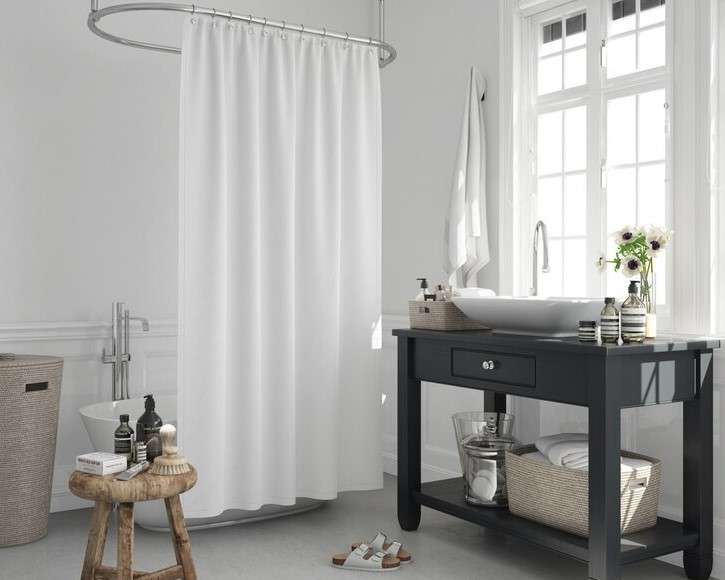Choosing the right shower curtain can change your bathroom from dull to delightful. It’s not just a functional item; it shows your style and enhances your space.
With so many options—patterns, colors, and materials—finding the right one can be tough. But don’t worry! Knowing your needs will help you narrow down the choices.
Whether you want a sleek look or a bold splash of color, the right curtain will bring the room together.
This guide will cover what to think about when picking a shower curtain. We’ll help you find one that fits your needs and matches your style.
So, let’s dive in! Discover how to enhance your bathroom with ease. Keep reading for inspiration!
Shower Curtain Selection Made Easy: Top 8 Things to Consider
1. Types of Shower Curtains

There are many different types of shower curtains available on the market, each with its own unique benefits and drawbacks. Here are a few of the most popular types:
- Plain shower curtains are a classic choice that are available in a variety of colors and patterns. They are typically made from a lightweight fabric, such as polyester or cotton, and are easy to care for.
- PEVA shower curtains are made from a waterproof plastic material that is resistant to mold and mildew. They are also more durable than traditional shower curtains, making them a good choice for high-traffic areas.
- Curtain liner is a waterproof fabric that is placed behind the shower curtain to protect the walls and floor from water damage. Liners are available in a variety of colors and patterns, and they can help to extend the life of your shower curtain.
- Shower curtains with a built-in liner are a convenient option that eliminates the need to purchase a separate liner. These curtains are typically made from a waterproof fabric, and they are available in a variety of colors and patterns.
2. Materials for Shower Curtains
The material of your shower curtain is an important consideration, as it will affect the overall look and feel of your bathroom. Here are a few of the most common materials used for shower curtains:
- Polyester is a lightweight, durable fabric that is easy to care for. Polyester shower curtains are typically machine-washable and wrinkle-resistant.
- Cotton is a natural fiber that is soft and absorbent. Cotton shower curtains are typically more expensive than polyester curtains, but they are also more breathable and luxurious.
- PEVA is a waterproof plastic material that is resistant to mold and mildew. PEVA shower curtains are typically more durable than traditional shower curtains, but they can be more difficult to care for.
- Vinyl is a synthetic plastic material that is waterproof and durable. Vinyl shower curtains are typically less expensive than other types of shower curtains, but they can be more difficult to care for.
3. Color and Pattern Options

The color and pattern of your shower curtain can make a big impact on the overall look and feel of your bathroom. Here are a few things to consider when choosing a shower curtain:
- The size of your bathroom. If you have a small bathroom, you may want to choose a light-colored shower curtain with a small pattern. This will help to make the bathroom feel more spacious.
- The style of your bathroom. If you have a modern bathroom, you may want to choose a shower curtain with a geometric pattern or a bold color. If you have a traditional bathroom, you may want to choose a shower curtain with a floral pattern or a neutral color.
- Your personal style. Choose a shower curtain that reflects your personal style. If you love bold colors and patterns, go for it! If you prefer a more minimalist look, choose a simple shower curtain in a neutral color.
4. Size and Length
The size and length of your shower curtain are important considerations, as they will affect the overall look and function of your bathroom.
Here are a few things to keep in mind when choosing a shower curtain:
- The size of your shower. The shower curtain should be at least 6 inches wider than your shower stall and 10 inches longer than the shower head. This will help to keep the water from splashing out of the shower.
- The height of your shower curtain rod. The shower curtain should be long enough to reach the floor when it is pulled closed. This will help to keep the water from splashing onto the floor.
- The style of your shower curtain. If you have a shower curtain with a decorative valance, you may want to choose a shorter shower curtain. This will allow the valance to be seen.
5. Hooks and Rings
The hooks and rings that you use to hang your shower curtain are an important consideration, as they will affect the overall look and function of your bathroom.
Here are a few things to keep in mind when choosing shower hooks and rings:
- The material of your shower curtain. If you have a heavy shower curtain, you will need to use heavy-duty hooks and rings.
- The style of yourshower curtain. If you have a modern bathroom, you may want to choose chrome hooks and rings. If you have a traditional bathroom, you may want to choose brass hooks and rings.
- The number of hooks and rings. You will need one hook for every 12 inches of shower curtain.
6. Installation

Installing a shower curtain is a relatively simple task that can be completed in just a few minutes. Here are the steps involved:
- Measure the width and height of your shower stall.
- Cut the shower curtain to the desired length.
- Install the shower curtain rod.
- Attach the shower curtain hooks to the shower curtain rod.
- Hang the shower curtain.
Here are a few tips for installing a shower curtain:
- Use a level to make sure that the shower curtain rod is installed straight.
- Use a stud finder to find the studs in your wall and attach the shower curtain rod to the studs. This will help to prevent the rod from slipping.
- Use shower curtain hooks that are the right size for your shower curtain. This will help to prevent the curtain from slipping off the hooks.
7. Care and Maintenance

To keep your shower curtain looking its best, it is important to care for it properly. Here are a few tips for caring for your shower curtain:
- Wash your shower curtain regularly. Shower curtains can get dirty quickly, so it is important to wash them regularly. You can wash your shower curtain in the washing machine on a gentle cycle.
- Use a mild detergent. Use a mild detergent when washing your shower curtain. Harsh detergents can damage the fabric of your shower curtain.
- Air dry your shower curtain. Do not dry your shower curtain in the dryer. The heat from the dryer can damage the fabric of your shower curtain.
8. When to Replace Your Shower Curtain
There are a few signs that it is time to replace your shower curtain. Here are a few things to look for:
- The shower curtain is torn or damaged. If your shower curtain is torn or damaged, it is time to replace it. A torn or damaged shower curtain can be a safety hazard.
- The shower curtain is mildew-stained. If your shower curtain is mildew-stained, it is time to replace it. Mildew can cause health problems, so it is important to remove it from your shower curtain as soon as possible.
- The shower curtain is outdated. If your shower curtain is outdated, it is time to replace it. A new shower curtain can update the look of your bathroom and make it feel more fresh and inviting.
Conclusion
In conclusion, selecting the perfect shower curtain involves a thoughtful consideration of several key factors. First and foremost, understanding the dimensions of your shower space is essential to ensure a proper fit.
Additionally, evaluating the material of the curtain is crucial for both durability and style. Whether opting for vinyl, polyester, or fabric, each material offers distinct advantages to cater to individual preferences.
Moreover, paying attention to the design and pattern of the curtain can contribute significantly to the aesthetic appeal of your bathroom. Balancing functionality with aesthetics is paramount in making the right choice.
Lastly, considering maintenance requirements and ease of cleaning can ensure long-term satisfaction with your selection. By taking into account these factors, you can confidently choose a shower curtain that not only complements your bathroom decor but also meets your practical needs.
What type of hooks or rings are best for hanging a shower curtain?
When choosing the best hooks or rings to hang your shower curtain, there are various elements to consider to ensure both functionality and aesthetic appeal. Let’s explore the world of shower curtain accessories to find the greatest solutions for your bathroom retreat.
First and foremost, material matters. Choosing hooks or rings made of robust materials like stainless steel, brass, or even high-quality plastic ensures longevity and resistance to rust or corrosion in the wet bathroom environment. These materials not only survive the rigors of daily use, but they also provide an air of beauty to your shower area.
Next, think about the style and design of the hooks or rings. From classic ball hooks to modern roller rings, there are numerous ways to accent your shower curtain and overall bathroom design. Choose a style that reflects your unique preferences and improves the visual appeal of your bathing retreat.
When choosing shower curtain hooks or rings, functionality comes first. Look for alternatives that slide effortlessly along the curtain rod, allowing the curtain to open and close smoothly. Additionally, choose hooks or rings with secure closures to keep the curtain from slipping or dropping during use, providing piece of mind and convenience.
Furthermore, adaptability increases the value of your shower curtain accessories. Some hooks and rings have creative designs that can accept a variety of curtain styles, such as traditional cloth curtains and modern shower liners. This versatility assures compatibility with a variety of curtain styles, providing flexibility and ease for your bathing requirements.
To summarize, the best hooks or rings for hanging a shower curtain combine durability, style, usefulness, and versatility to enhance your bathroom experience. By carefully examining these characteristics, you can select the ideal accessories to make your shower into a haven of relaxation and pleasure.
Should I choose a patterned or solid shower curtain for my bathroom?
When determining whether to use a patterned or solid shower curtain in your bathroom, you must consider both aesthetics and utility in order to create a place that reflects your unique style while also performing its practical purpose successfully.
Patterned shower curtains can bring individuality and visual interest to your bathroom. They come in a variety of designs, from bold geometric shapes to delicate floral prints, allowing you to express your particular style while also improving the overall mood of the space. Whether you choose a modern, eclectic, or classic design, there is a pattern to fit every style.
Solid shower curtains, on the other hand, are more subtle in their elegance and adaptability. Choosing a solid color for your bathroom can help to create a coherent and peaceful ambiance, making it feel more spacious and quiet.
Furthermore, solid curtains can seamlessly match current decor and color schemes, acting as a timeless backdrop for other design elements to flourish.
Consider the size and arrangement of your bathroom while making a decision. In smaller bathrooms, a solid curtain in a light color can assist brighten the space and provide the idea of more space, but a patterned curtain may overpower the space.
In contrast, in bigger bathrooms with plenty of natural light, a vibrant pattern can serve as a focal point and add flair to the area.
Finally, whether you choose a patterned or solid shower curtain depends on your personal preferences and the overall style you want to achieve. Don’t be afraid to mix and match patterns and solids in your bathroom to achieve a cohesive and visually appealing appearance that reflects your individual style and personality.
How do I know if a shower curtain is water-repellent or waterproof?
Determining whether a shower curtain is water-repellent or waterproof is critical for a dry and hassle-free bathing experience. While the terms “water-repellent” and “waterproof” may sound similar, they have distinct properties that influence their effectiveness in moist environments.
First, let’s look at the concept of water repellency. A shower curtain marketed as water-repellent can withstand water to a certain extent. When water comes into touch with the surface of a water-repellent curtain, it tends to bead up and slide off rather than permeating the material right away.
This characteristic is beneficial because it prevents water from soaking into the fabric, lowering the possibility of mold and mildew formation.
A waterproof shower curtain, on the other hand, goes above and above in terms of water resistance. A waterproof curtain, unlike its water-repellent sibling, is designed to prevent water from permeating its whole surface.
This means that it not only repels water on touch, but it also forms a barrier to prevent moisture from seeping through, resulting in a completely dry enclosure.
There are several basic methods for determining if a shower curtain is water-repellent or waterproof. First, carefully study the product label or packaging for any indicators of water resistance. Manufacturers frequently specify whether their curtains are water-repellent or waterproof.
Furthermore, you may do a practical test by spraying a little amount of water onto the curtain’s surface and watching how it reacts. If water beads up and easily rolls off, it’s probably water-repellent. However, if the water remains on the surface without seeping through, you have a waterproof curtain.
By being acquainted with these distinctions and using practical testing methods, you can confidently choose a shower curtain that matches your preferences and provides a dry and comfortable bathing experience.
What type of shower curtain hooks or rings work best with different types of shower curtains?
Choosing the right shower curtain hooks or rings can elevate your everyday shower routine from dull to magnificent. With so many options available, it’s critical to match the proper sort of hooks or rings to your shower curtain for maximum usefulness and visual appeal.
For fabric shower curtains, consider using double-glide hooks or rings. These multipurpose accessories have two hooks that enable for smooth movement and easy opening and closing of the curtains. The dual design decreases friction, avoiding wear and tear on sensitive fabric fabrics, while also allowing for easy cleaning and replacement.
Plastic shower curtains work perfectly with C-shaped or S-shaped hooks. These basic yet practical designs provide dependable support and durability for lightweight curtains. The curved design of these hooks provides a firm grasp on the curtain rod, avoiding slippage or sagging over time.
Furthermore, the smooth surface of the plastic hooks glides easily along the rod, providing a hassle-free shower experience.
For heavy-duty vinyl or polyester shower curtains, use rollerball hooks or rings. Rollerball hooks, designed with durable materials and reinforced construction, slide effortlessly over the curtain rod, even with heavier drapes.
The ball bearings inside the rollers ensure smooth movement and reduce friction, preserving the curtain’s integrity and increasing its lifespan.
If you want a more beautiful and sophisticated appearance, decorative shower curtain hooks provide an ideal balance of design and functionality. From complex motifs to elegant metallic finishes, these hooks elevate any bathroom decor while firmly holding your shower curtain in place.
In conclusion, the ideal shower curtain hooks or rings are determined by the material and weight of the curtain, as well as your particular design choices. By choosing the right hooks or rings, you may improve the utility and visual attractiveness of your shower area, providing a peaceful retreat for your regular cleansing rituals.
